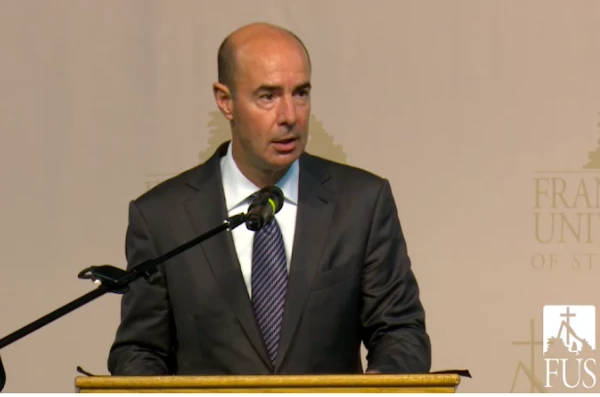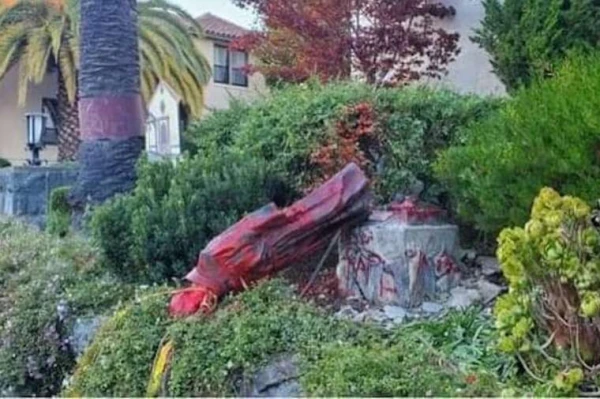US Labor Secretary: America still needs Columbus Day

CNA Staff, Oct 13, 2020 / 06:03 pm (CNA).- Opponents of Columbus Day are misguided in their criticism and miss the important message about unity and inclusivity that the holiday continues to offer America, U.S. Secretary of Labor Eugene Scalia said this week.
“Columbus Day stands for ideals and principles that are woven into the fabric of our nation, and which are as important today as they were on the first Columbus Day in 1892,” he said.
Scalia spoke at Franciscan University of Steubenville on October 12. He reflected on criticisms of Christopher Columbus and the holiday that bears the explorer’s name.
“Columbus Day has been part of our American heritage for more than a century. There are some now who would like to do away with that commemoration. My message is that would be a mistake,” he said.
The labor secretary noted calls for Columbus Day to be re-designated as a day recognizing Native Americans. However, he said, honoring Native Americans can be accomplished without dishonoring the groups who have drawn inspiration from Christopher Columbus over the centuries.
“That first Columbus Day welcomed Catholics and recent immigrants as equal sharers in the American dream, and acknowledged—if only for a day— Native Americans as rightful participants in our national heritage,” he said. “Maligned by progressives today, Columbus Day was an early celebration of something progressives purport to value—diversity and inclusion.”
Numerous acts of vandalism and destruction against statues of Columbus and other historical figures have taken place in recent months, with officials removing other statues to protect them from the threat of mob attacks.
More than 30 statues of Columbus have been or are scheduled to be removed, Scalia said. Other statues across the country have also been torn down, including those depicting “Star-Spangled Banner” author Francis Scott Key, president and Union general Ulysses Grant, and Saint Junipero Serra.
Statues and memorials honoring George Washington, Thomas Jefferson, and Abraham Lincoln have also faced calls for removal.
Scalia warned that the activists driving the opposition to these statues “want to fundamentally redefine how we view our nation’s character and legacy,” proposing a vision of America as fundamentally oppressive and discriminatory.
However, he suggested, contemporary Americans can gain valuable insight about the country and its heritage from considering why previous generations revered Columbus.
The early American revolutionaries were inspired by Columbus’ great courage, which opened the door to new opportunities and “boundless possibilities,” Scalia said.
“Through the centuries, Columbus came to represent the spirit of adventure and discovery that we associate with America—our faith in our capacity to seek and find something new and better,” he said. “We have many heroes who personify our political ideals, but no figure so associated with the questing, the entrepreneurialism, the hope in the new that is part of the American spirit.”
Columbus was not perfect, Scalia acknowledged, and in fact had “grave faults.”
“He participated in the slave trade—as did others in his day—and was a harsh, at times inhumane ruler of indigenous people he subjugated.”
Many of the historical figures we admire had serious shortcomings, Scalia said, noting that several of the Founding Fathers owned slaves.
“[W]e know that the Founders did not fully live according to the ideals they espoused. They were sinners; they were fallen—in that respect, they were like all of us here. And they lacked the vision to fully see the implications and promise of what they wrote,” he said. “But they supplied the vision and principles for generations of Americans to forge the freest nation on earth—and they had the genius to craft a Constitution that made fulfilling those ideals possible.”
Heroes in the cause of civil rights embraced the founding era documents, despite the flaws of those who wrote them, Scalia said.
He noted that Frederick Douglass called the Constitution a “glorious liberty document,” and Martin Luther King Jr. famously said, “When the architects of our Republic wrote the magnificent words of the Constitution and the Declaration of Independence, they were signing a promissory note.”
King offers the country today an example of how to embrace what was good in the American founding, while rejecting errors and “calling on America to be even more American—to be ever truer to the Founders’ vision,” Scalia said.
The Knights of Columbus, a Catholic fraternal organization engaging in charitable work, was founded in 1882, taking the name of Columbus, Scalia said, citing a historian who said the Knights viewed Columbus as a “hero against American nativism, a symbol providing ‘social legitimacy and patriotic loyalty.’”
When Columbus Day was first celebrated nationally in 1892, it was presented by President Benjamin Harrison as a day of unity, which those from the North and South could celebrate together, the labor secretary said.
Over time, Columbus also came to be honored by immigrants – especially Italian and Irish Catholics – who faced strong discrimination in America, he added.
“[I]n the 19th century, in the face of sharp hostility associated with religion and national origin, Columbus became a powerful symbol of the claim of Italian, Irish, and other Catholic immigrants that they were fully American,” he said.
“The nation’s Protestant elite proudly claimed forebears among the sons and daughters of the Revolution; Columbus was an equally proud answer that Italians and Catholics, also, had roots in the nation’s founding and a claim to be fully American.”
This message of diversity and inclusion offered by Columbus Day is still needed in America, Scalia said.
He recalled the 2018 confirmation hearing of Brian Buescher, a judicial nominee and member of the Knights of Columbus who was told by Senators that the Knights take “extreme positions” and was asked if he was willing to resign his membership in the organization “to avoid any appearance of bias.”
He also pointed to Supreme Court nominee Amy Coney Barrett facing scrutiny for her faith and participation the charismatic Christian group People of Praise. Barrett was told by a senator at a 2017 hearing, “[T]he dogma lives loudly within you, and that’s of concern.”
Scalia also said the Department of Labor is working to remove regulations that require religious charitable organizations to warn the people they serve about their religious nature and refer them elsewhere if they object to it.
He added that President Donald Trump signed an order last month prohibiting race and sex scapegoating and stereotyping in federal workplace training programs. Scalia said the order will help fight training programs that tell certain employees that they are racist or morally culpable because of their race or sex.
“Harboring racist views is not the shared heritage of white Americans. For many it’s quite the opposite, as Columbus Day reminds us: Catholics, Irish, Italians, Poles, Jews, and others had their own struggles gaining acceptance in American society,” Scalia emphasized.
“Columbus Day is a day about overcoming that; it’s a day that was first set aside to embrace this country’s diversity and welcome all citizens into the American polity, regardless of creed or national origin.”
While there is still work to do in this regard, abandoning Columbus Day does not help achieve that purpose, he continued. Rather, Americans should be inspired by the rich history of Columbus Day to celebrate diversity and work for unity.
“Our nation did not establish Columbus Day to commemorate oppression or discrimination,” he said, “we established Columbus Day to overcome it.”


